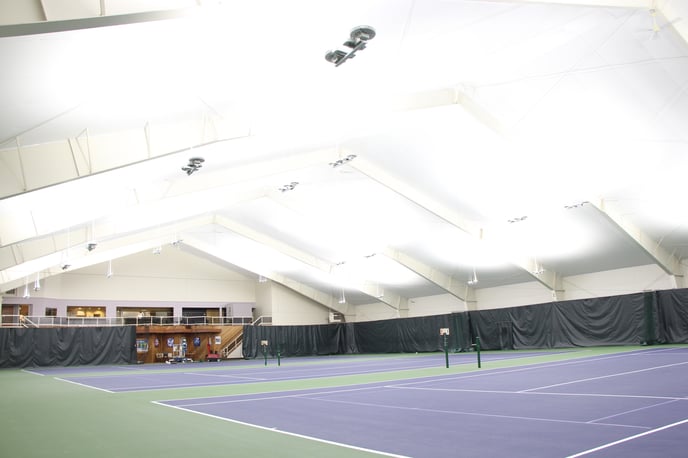Keys to an Amazing Indoor Tennis Facility
With how extensively Sports Interiors travels to indoor tennis facilities around the country meeting with owners and management, we have been able to establish a deep understanding of what makes a tennis club successful.
 Pleasant Valley Tennis & Fitness in Jackson, WI
Pleasant Valley Tennis & Fitness in Jackson, WI
With how extensively Sports Interiors travels to indoor tennis facilities around the country meeting with owners and management, we have been able to establish a deep understanding of what makes a tennis club successful. In addition to the 100+ indoor tennis facilities we travel to annually, Sports Interiors is comprised of athletic club owners, managers, former tennis pros and front desk managers. We have seen it all when it comes to tennis facility operations and management. We thought we would share a few of our thoughts on the matter. Successful tennis clubs provide more than just a place to play tennis. They are a welcoming hub of activity that has something for everyone. Cliff Drysdale, a former professional tennis player and 2013 inductee into the International Tennis Hall of Fame, owns a tennis management company, Cliff Drysdale Tennis, which now manages 26 locations and growing. When it comes to managing a tennis facility, Drysdale states: “The main challenge is getting the right people, the right professionals, and the right leaders. It takes a very special talent. You have to deal with the politics of the club, you have to be able to teach, and more than anything, you have to be a promoter.”
To begin with, a successful tennis facility must build engagement with the community. One of the best examples is Greater Midland Tennis in Michigan where there is a very supportive and success-seeking community. It would be unfair to mention Greater Midland’s success without mentioning former Executive Director, Mike Woody, and the impact he has had on the facility. Woody helped the Midland Tennis Center earn the title as the first USTA’s Best Tennis Town in 2009.
In conjunction with building community involvement, a successful tennis club hires passionate coaches, who are appropriately qualified/certified, and have the actual playing skill. Finding these three qualities in a prospective coach can be a very good sign, as it will increase the probability of locating a tennis coach who will be able to successfully teach students. On top of these three qualities, it is important for a tennis teacher to be an advocate of the club and the game.
In terms of tennis facilities across the US, there is considerable variation in player demographics, staff size, and budgets. They may be public or municipal, commercial or private, tennis-only or offer multiple programs. About the only common denominator is that in tennis facilities, managers and owners have multiple responsibilities. The state of the industry requires a readiness for the next challenge and need to diversify. No matter whether a facility serves families in the suburbs or is situated in the middle of a retirement community, no matter whether it’s a high-end club in a gated community or a public facility in the middle of a major city, owners and managers say that the key to survival is staying fresh and ready for whatever shot the economy puts over the net next.
The Importance of Tennis Lighting
There is an almost endless list of topics to cover when discussing what makes a tennis facility successful. With over 30 years of experience in the indoor tennis industry, we understand the key ingredients to a well-run facility. For example, having a proven LED Tennis Lighting System and Liner System will help create an amazing indoor tennis experience which can impress current members and attract new players. If you would like to discuss how Sports Interiors can help your facility, please contact us at 847-892-6956 or simply click on the button below to reach one of our team members!
See some of the facilities where we have installed our Lighting &
![Sports_Interiors_Logo_Design-2.png]](https://knowledgebase.sportsinteriors.com/hs-fs/hubfs/Sports_Interiors_Logo_Design-2.png?height=50&name=Sports_Interiors_Logo_Design-2.png)
